Here it is: the much anticipated gluten free sourdough bread recipe!
I’ve made so many gluten free sourdough loaves over the past few years that I’ve accumulated quite a few yummy photos!
Pictures like this gluten free sourdough made in my Emile Henry bread baker …
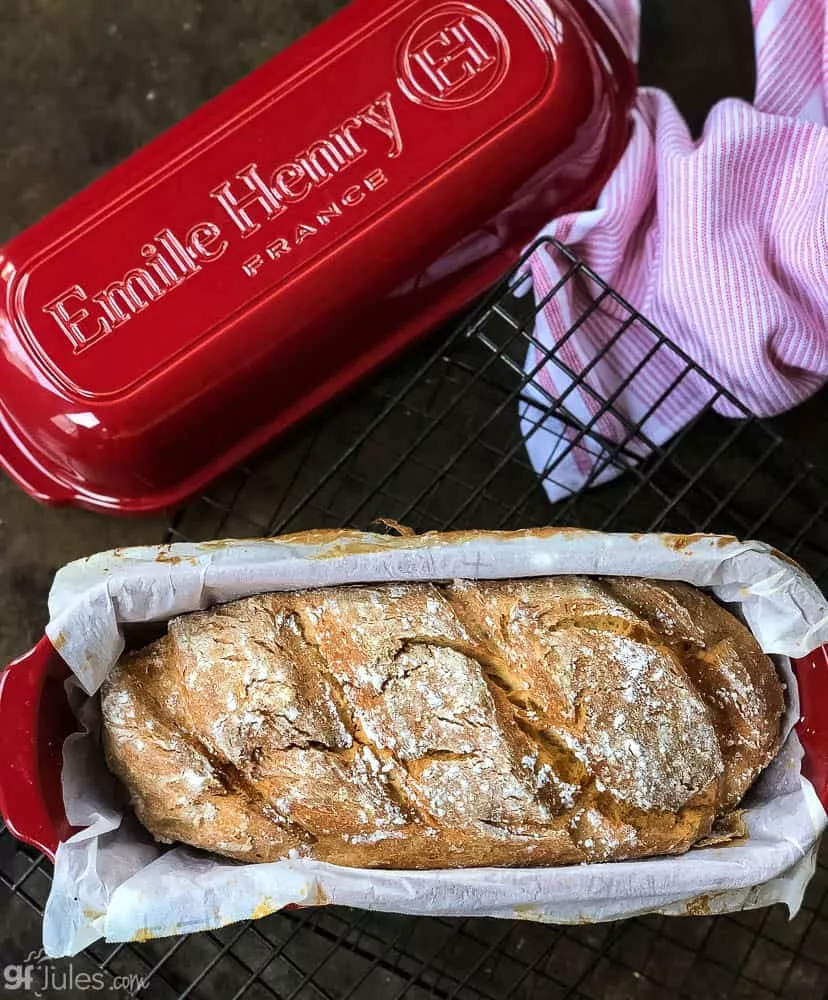

or this gluten free sourdough baked in a Pullman Pan …
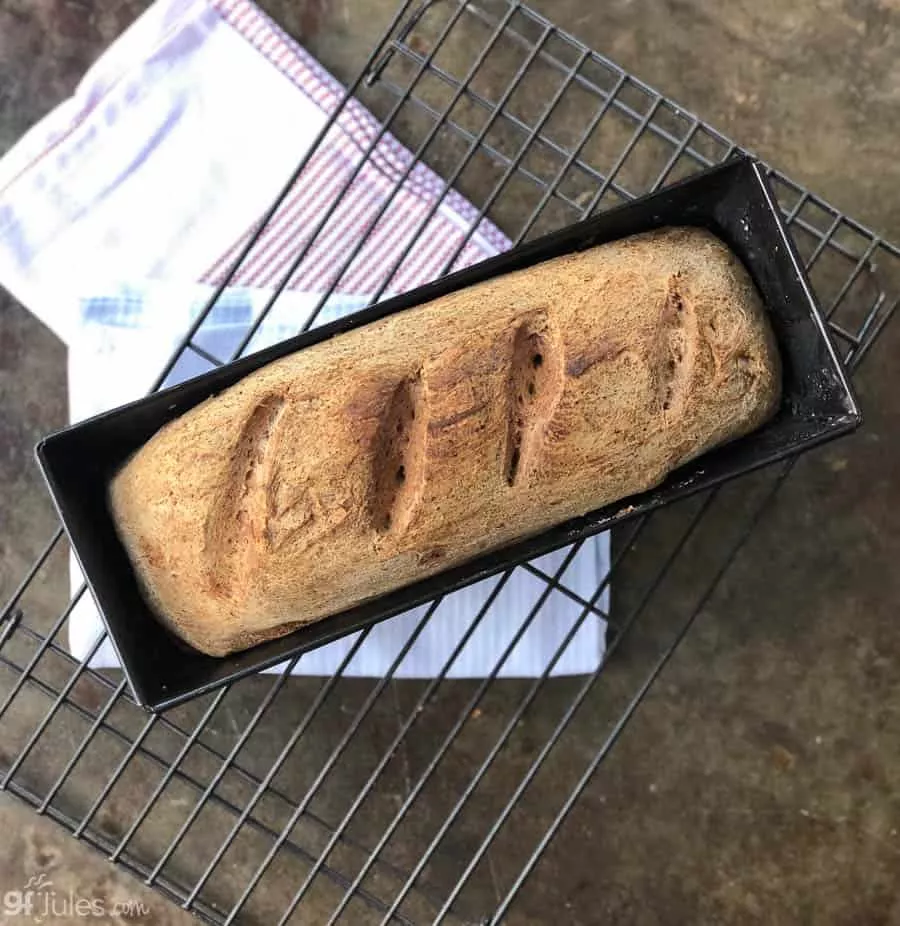

or this gluten free sourdough baked as a boule without a pan …
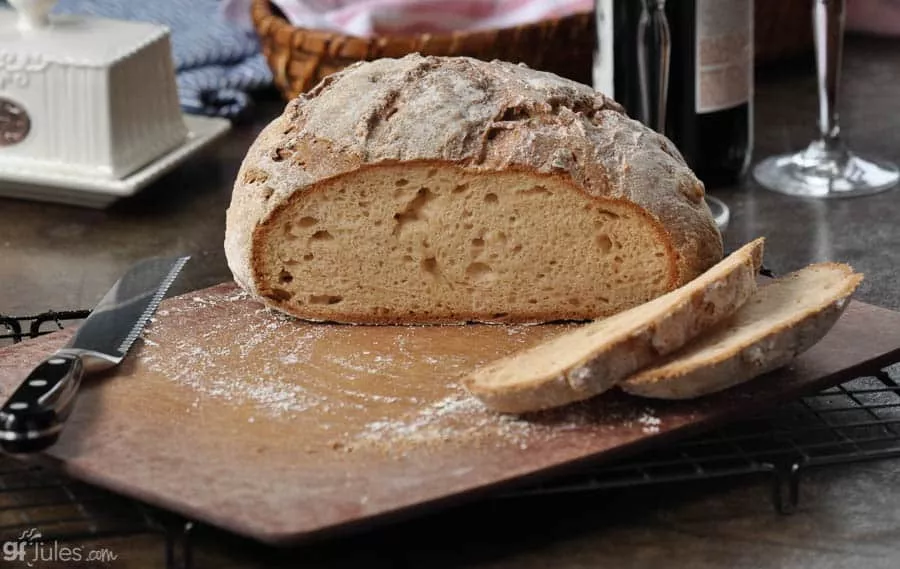

I’ve baked experiment after experiment, tweaking it here and there to account for lots of variables.
The development of a gluten free sourdough starter and gluten free sourdough bread recipe was a painstaking process, but at least we’ve enjoyed tons of gluten free sourdough (by the way, leftover sourdough makes an insane overnight gluten free French Toast Casserole!).
I urge you to hang in there and read through my entire post, as I outline what has worked best and what has not worked best for me. There are definitely some tricks of the trade. But let me assure you that you can (and with this recipe, you will) enjoy sourdough again!
Gluten Free Sourdough Basics
For those who love and miss sourdough, take heart! The art of making sourdough isn’t lost without the gluten. There’s still a lot of feeding, caring and waiting for the sourdough starter to mature and bloom into all its potential.
I’ve actually made so much starter that I’ve given some away to neighbors with the promise of sharing the gluten free sourdough recipe soon (not soon enough, I am aware), but I just couldn’t throw any away when I’ve tended to it for so long! It’s like a little sourdough baby and you just can’t toss it out — I care about it! It’s “alive.”
You’ll see when you make this gluten free sourdough starter; you’ll see. You won’t want to discard any of the “extra” either. It’s precious. Here’s how to make your very own gluten free sourdough starter!
Some things are the same about making gluten free sourdough bread as they are with making any other gluten free bread. There’s no kneading the bread and stretching the gluten because there’s no gluten! Just follow my instructions to the letter, use my gfJules Gluten Free All Purpose Flour, and sit back to watch the magic happen.
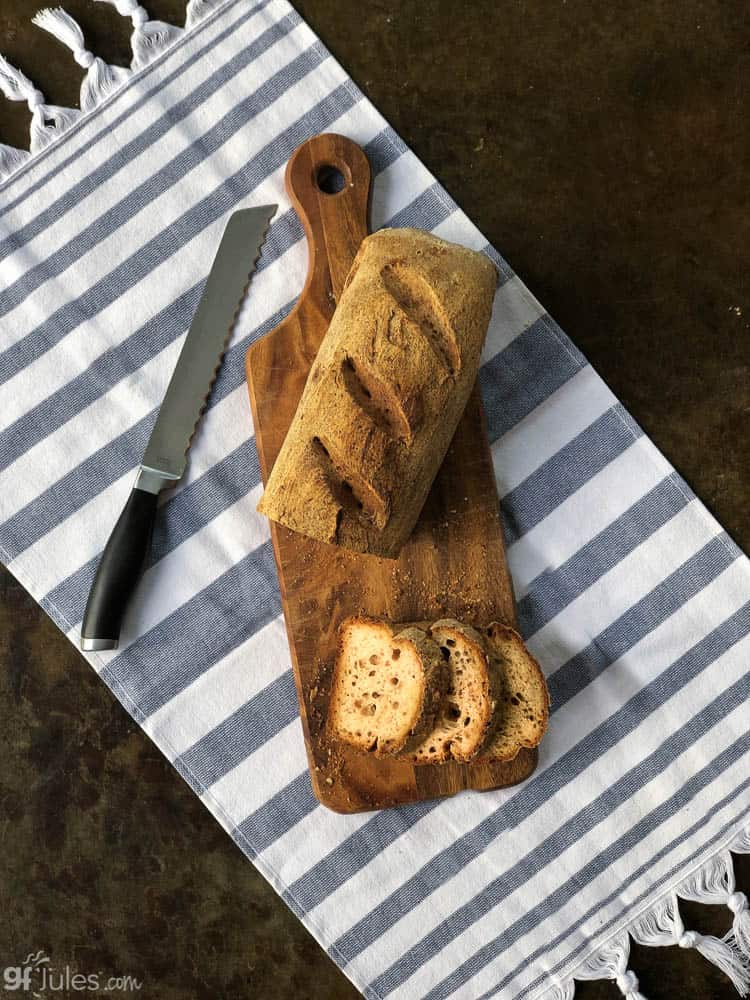

In anticipation of many questions to come, this recipe and process was developed using my gfJules Gluten Free All Purpose Flour because it works, I can rely on it every time, it’s easy, and it doesn’t taste funky or have any grit to it. If you try this recipe with another gluten free flour or blend, it really may not work, so please please please don’t even bother to try! But if you do, please don’t leave comments about how it didn’t work, because I’m telling you so before you waste your time.
Gluten free flours are tricky business. It took me two years to develop my original blend way back in 2003 (I’ve been gluten free since 1999!) and I’ve been tweaking and improving it ever since. Just because you think you can read ingredients and intuit how much of anything to use or to buy something off the shelf that sounds similar … you can’t. It won’t be the same, and the results won’t look like those pictured.
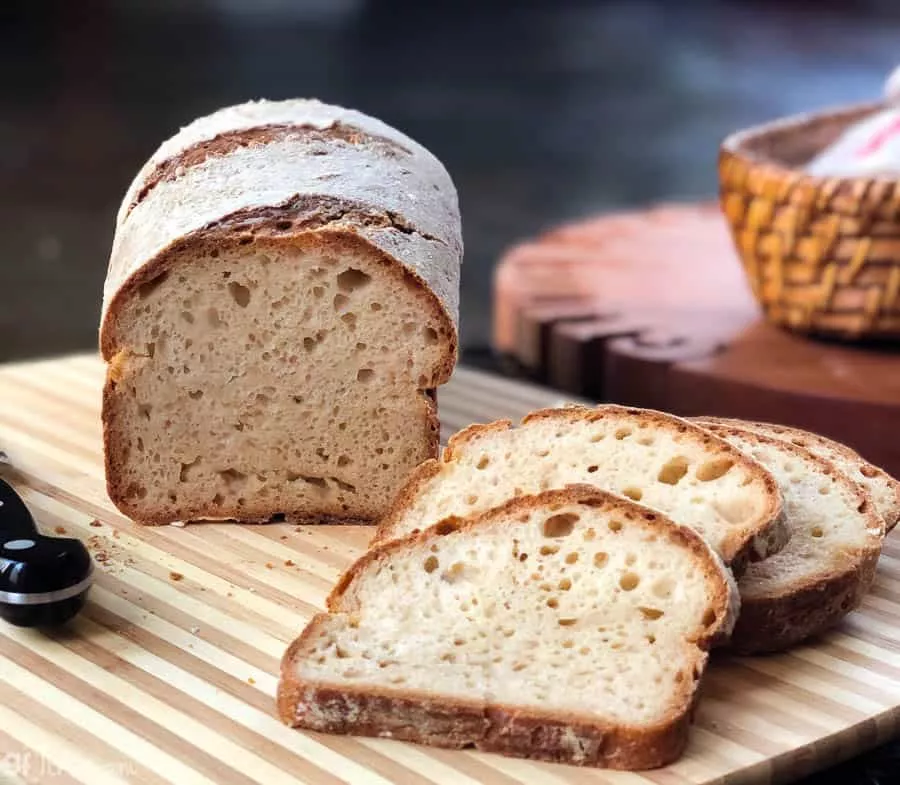

Not to put too fine a point on it, but tenths of a percentage point difference in proportions and a different brand or country of origin for any given ingredient are things that can make huge changes in outcomes. It amazes me all the time how tiny variances make big differences.
Which is why I developed my gfJules Flour to begin with. Selfishly, I didn’t want to have to make it in my kitchen every time I baked! And unselfishly, I wanted to prevent fellow gluten-free bakers (and newbies to gluten free baking) from having to mess around with mediocre flours only to achieve mediocre results. Gluten free baking — and specifically gluten free sourdough bread baking — can be so rewarding and share-worthy! You’ll see!
For more help with gluten free bread baking, in general, hop to my 18 Top Gluten Free Bread Baking Tips.
So back to the recipe at hand.
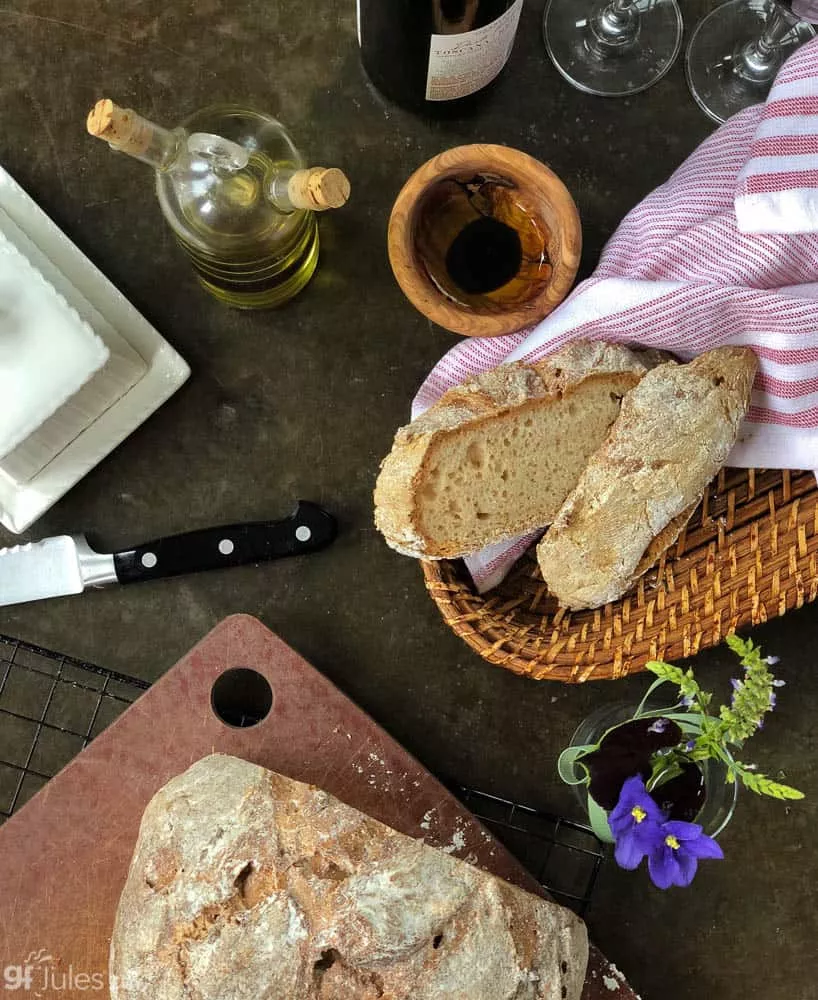

Baking Gluten Free Sourdough — Choosing the Right Pan
As you can see at the top of this post, there are many different options when it comes to baking your gluten free sourdough bread. If you prefer to make an artisan-style loaf, no bread pan is needed.
Follow along with one reader’s VIDEO of how she made her beautiful gluten free sourdough loaf using with this recipe and this artisan method following clicking here to watch!
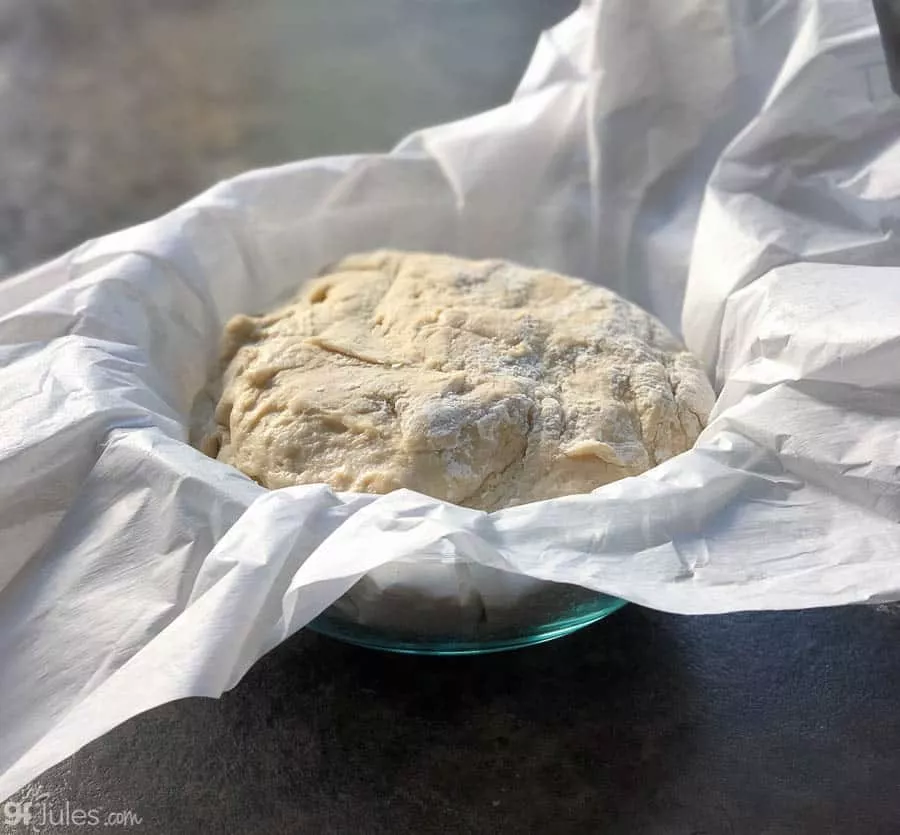

For that method, I found that lining a large glass bowl with oiled parchment sprinkled with more gfJules Flour was the best way to support the bread as it rose.
Once risen, I simply lifted up on the parchment and laid it out onto a baking sheet for the bread to bake.
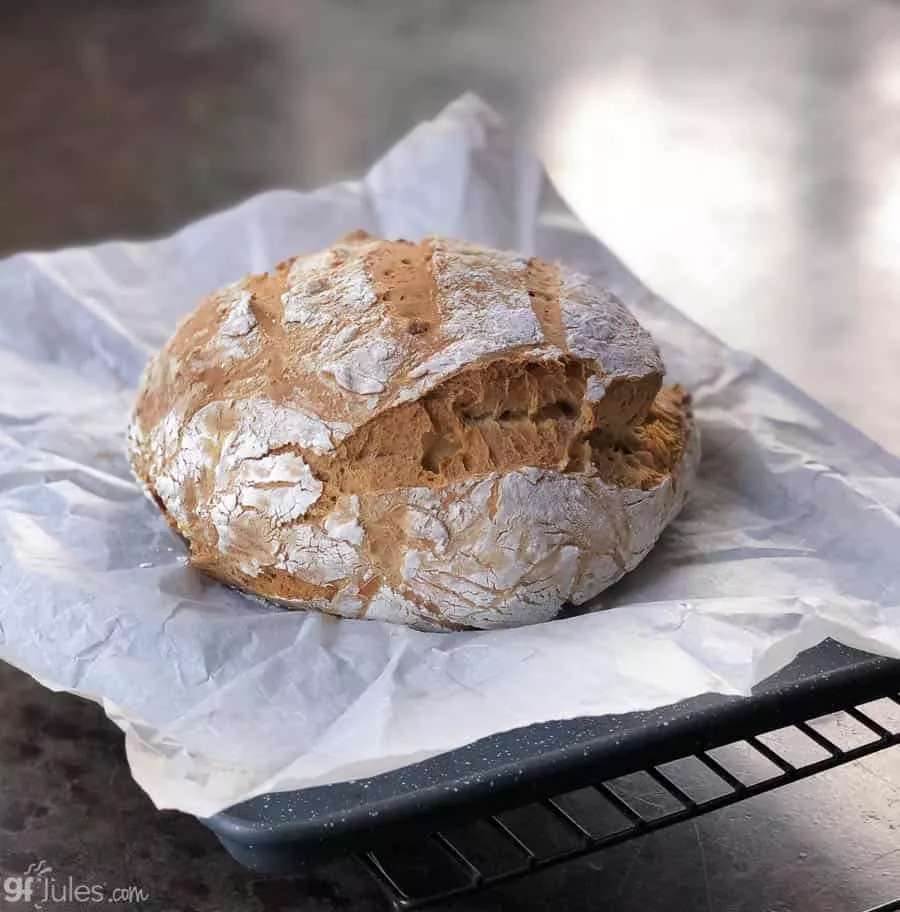

The bread will take more of a free-form shape, but it’s really beautiful and impressive!
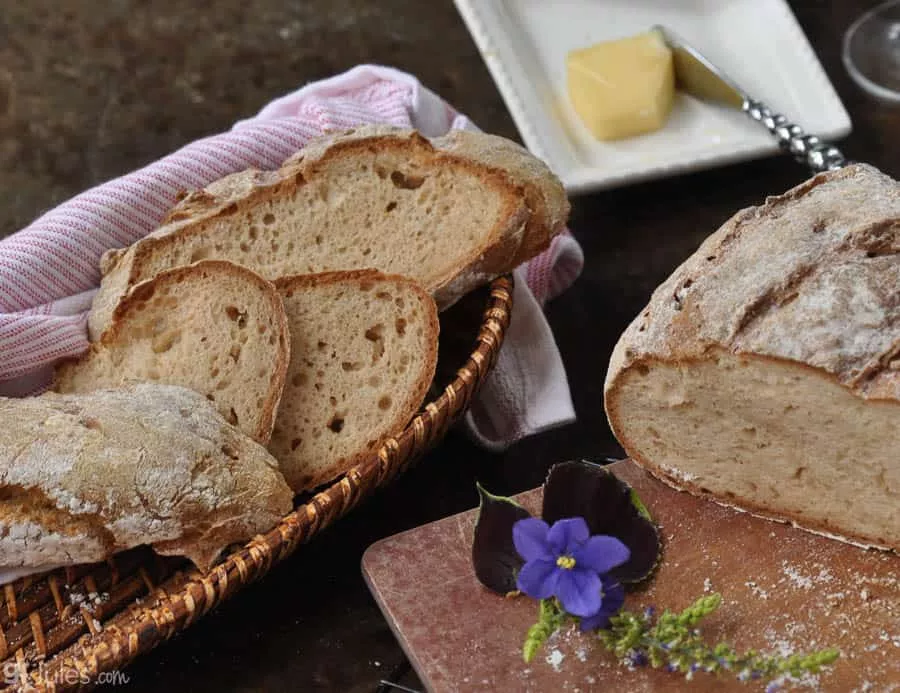

Using either the artisan or bread pan method, you may choose to dust the top of the loaf with gfJules Flour before baking for a more rustic look, or simply brush olive oil onto the top, or both.
I like the look of the flour with the golden finish of the olive oil in combination, so most of my loaves pictured are done that way.
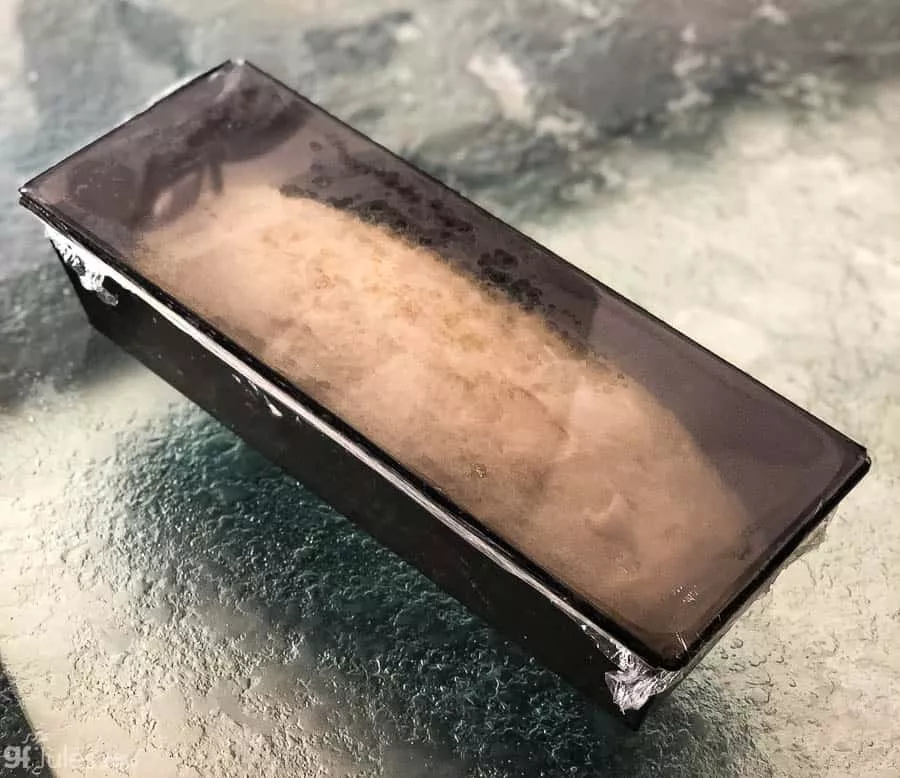

Allow the dough to rise covered with oiled plastic wrap to help keep the loaf warm and moist. I like putting the loaf into a preheated 200F oven, then turning the oven off, but turning the light on. I do this with the bread rising in either the bowl or the oiled and floured bread pan.
You can allow the bread to rise here for a minimum of 1 1/2 hours or up to one day if you’re baking egg-free.
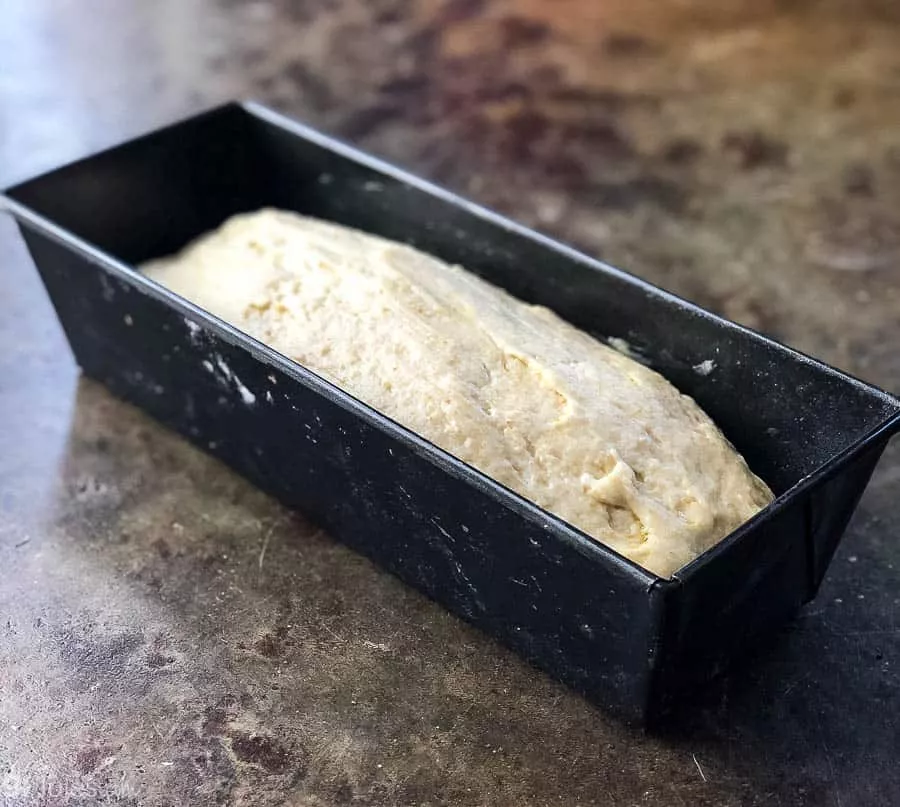

The bread won’t have risen a lot, as most of the rising happens when it’s baking.
Feel free to oil and flour the bottom and sides of the pan or use lightly oiled and floured parchment for easier removal from the pan.


After rising, cut slits in the top of the loaf to direct the rise. Since the oil and/or the flour were applied before the slits were cut, the inside of the slits will appear different from the crust and it gives the sourdough the hand-made look it deserves.
Regarding bread pans, I experimented with all kinds and sizes. My personal preference was the Pullman Pan that I used in most of these photos. The bread dough is a bit too voluminous for a traditional 9 x 5 (or smaller) bread pan; in those, this wet dough would rise high and then tended to collapse a bit, leaving some un-cooked looking areas in the center.
The Pullman Pan (mine is 12 x 4 1/2) seemed to be the perfect size to allow the bread to rise with support up the taller sides.
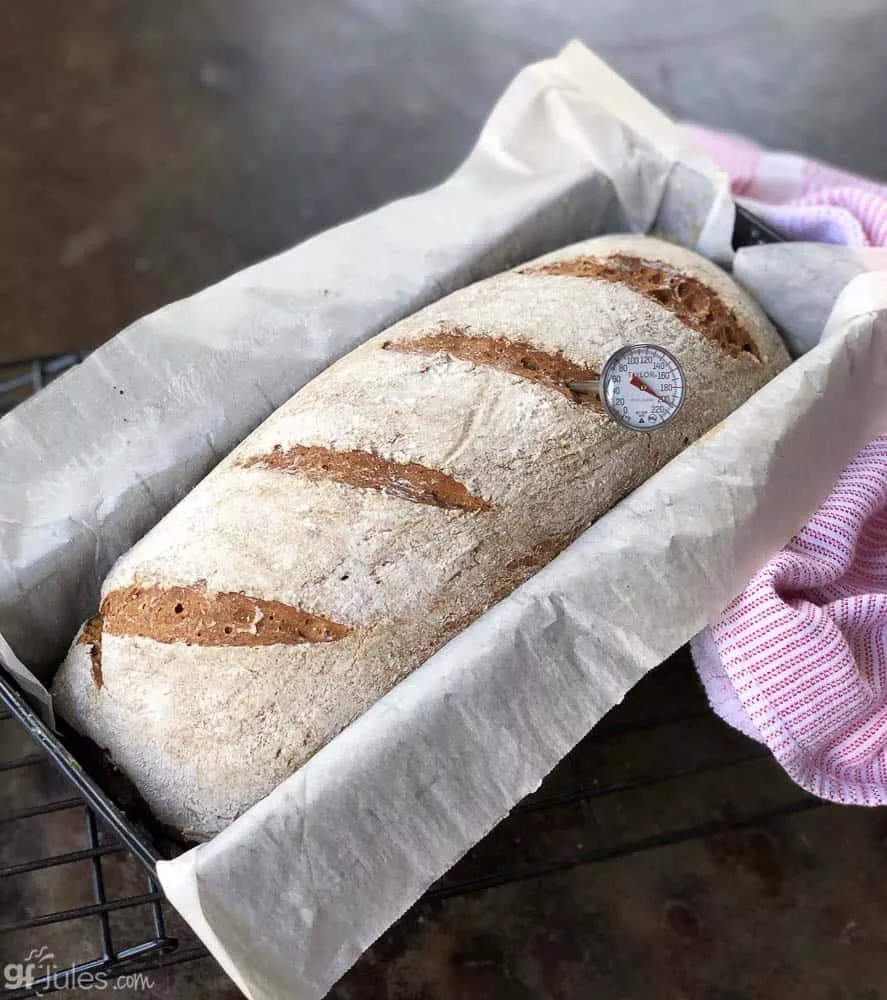

The time it takes to bake this bread will differ based upon the pan used and of course, on individual oven variations. I highly recommend buying an internal thermometer to take the bread’s temperature before removing it from the oven.
The internal temperature should be at least 205F before removing it from the oven to cool.
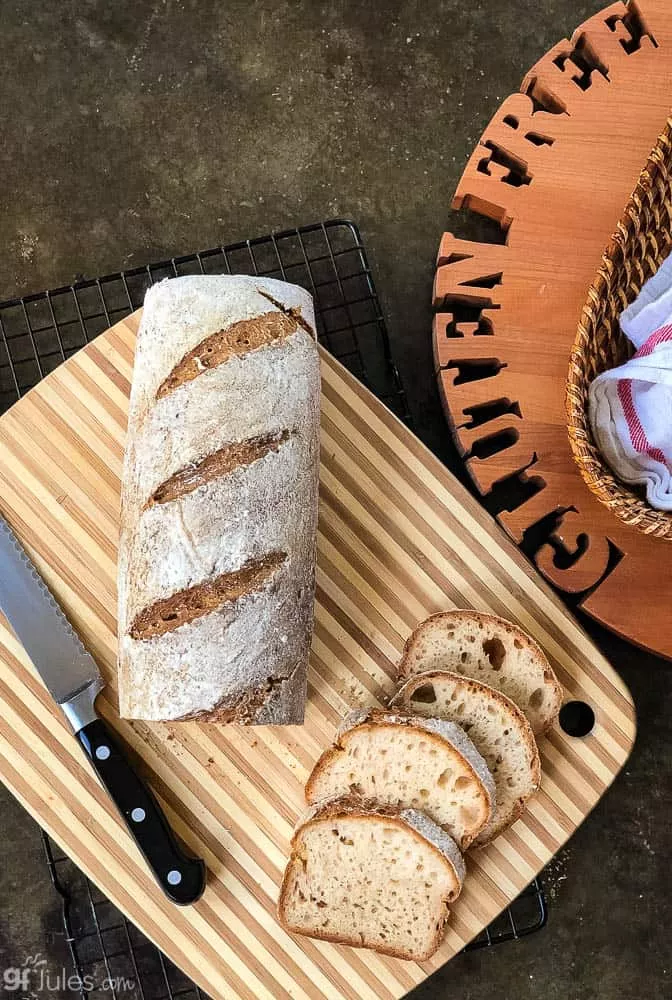

How to Make Gluten Free Sourdough Taste Sour
There are three main distinguishing features of sourdough: taste; smell and texture. You might expect that the most difficult feature to achieve in gluten free sourdough would be texture, but as you can see from the photos, the artisan texture, open cell structure and crunchy crust are present in each of my loaves made with my gfJules Flour or my gfJules Bread Mix.
The smell is something that is quite noticeable from the starter. It should be tangy and rather sour smelling to know it’s really active. If your starter isn’t smelling very sour, it needs to age longer and/or be fed more.
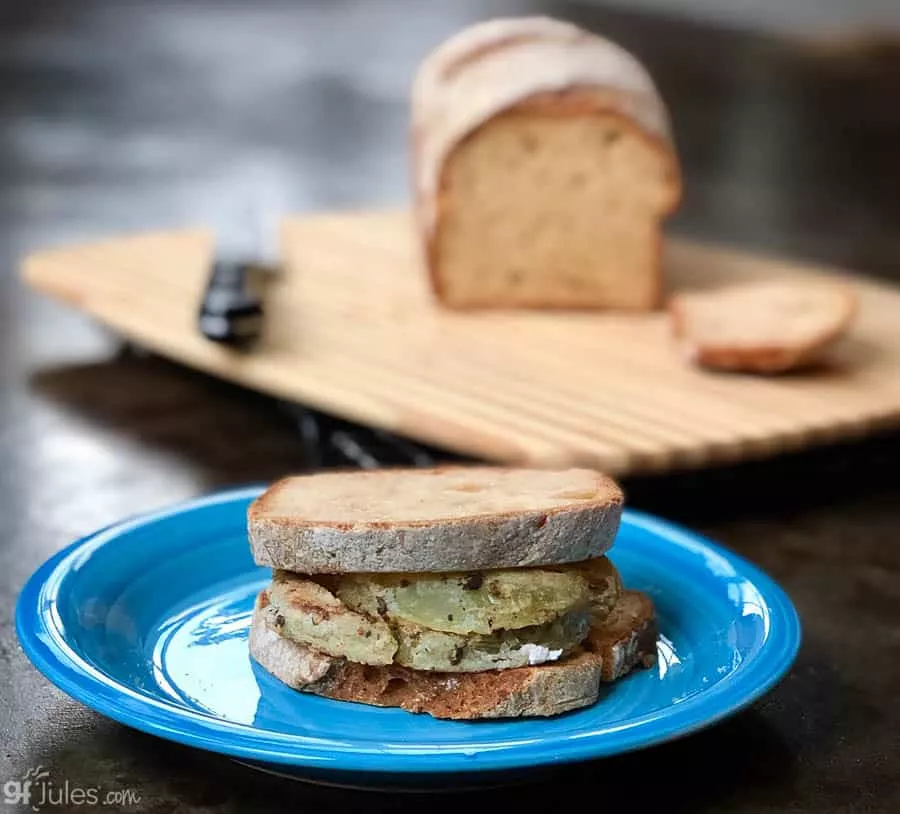

But the sour taste was the thing that seemed to be most elusive for me in my bread experiments. That’s fine for me, as I don’t prefer a sourdough taste in my bread, but I know many of you do.
My breads came out tasting yeasty and mild, just perfect for sandwiches or dipping in olive oil and balsamic (which we’ve been doing nearly every night for weeks now!).
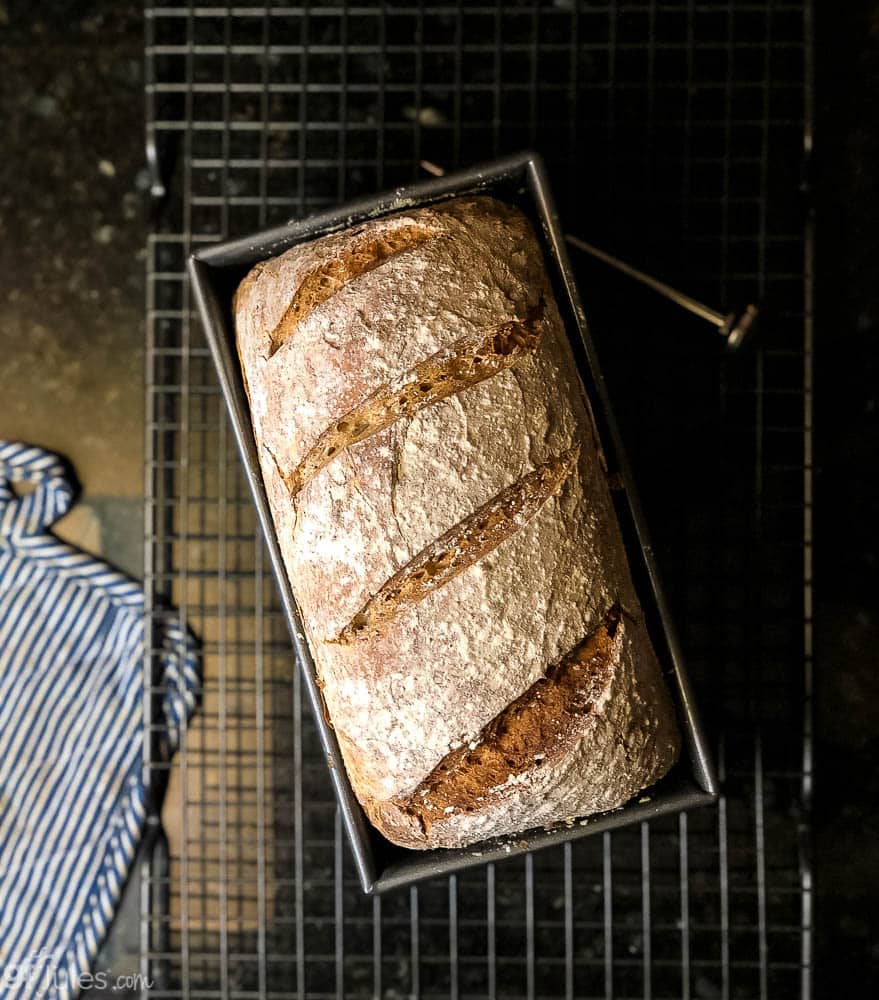

No, the sour taste didn’t come easily. I did achieve it when I allowed the bread to rise overnight, so if you are searching for that sour, I recommend budgeting time for an overnight rise.
I allowed my bread to rise as I described above, then placed it in the refrigerator overnight (still covered), then removed it the next day to sit on the counter to come to room temperature before baking. THEN the sour started to show through! (note: if you’re baking egg-free, leaving the dough covered in the oven turned off overnight is a good way to get that sour taste.)
Another site has recommended NOT feeding your sourdough starter again before baking with it in order to increase the sour flavor of the bread. This will also decrease the rise and will necessitate a longer proofing time, however. (Go here for the recipe to make your own gluten free sourdough starter)
If you do any experimenting of your own and find other ways to make this bread taste sour-er, please share in the comments below!


Storing Your Homemade Gluten Free Sourdough Bread
I always recommend storing your baked goods at room temperature in a sealed container, and this gluten free sourdough bread is no exception. The simple truth is that if you put baked goods into the refrigerator, they will dry out. You can put them into the freezer when they are fully cooled, but they will need to be warmed or toasted before enjoying again.
This gluten free sourdough bread is still soft and delicious after a few days in a zip top bag with the air squeezed out of it and stored at room temperature. Depending on the size of your loaf, you may need to cut it in half to get it to fit into a gallon sized bag, but other than that, it’s easy to just seal it up and grab a slice whenever you like!
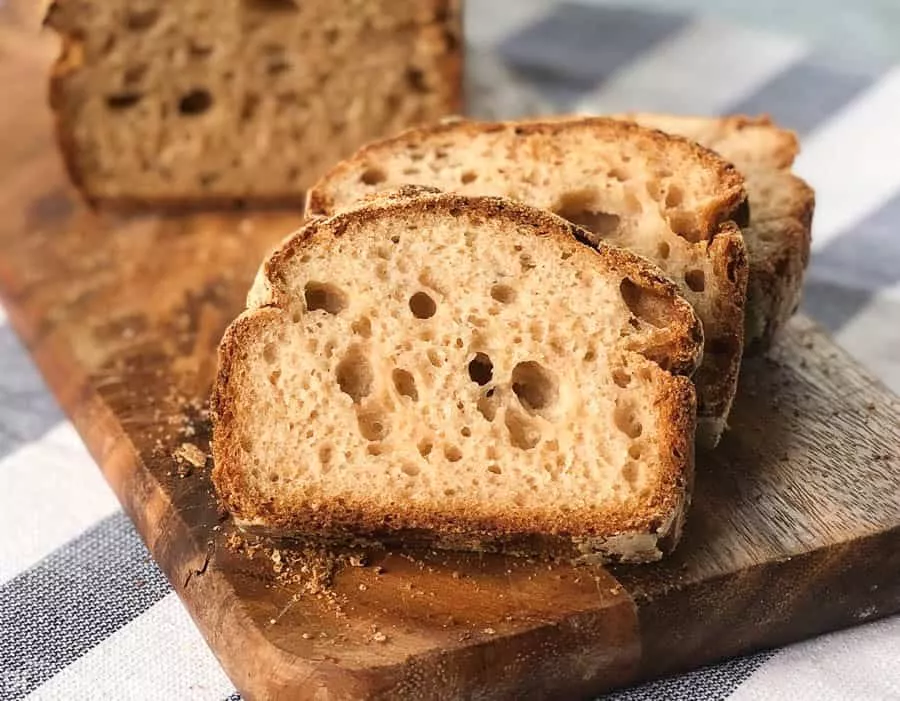

If you’d like to bake a regular gluten free artisan loaf without the sourdough starter, check out my Gluten Free Artisan Bread Recipe. And of course, my award-winning gfJules Gluten Free Bread Mix works well for any kind of sandwich bread, oven or bread machine, hamburger/hot dog bun or baguette recipe! Click on the “description” tab to find links to all these gluten free bread recipes or use the search bar above.
So let’s get down to baking great gluten free sourdough, shall we?
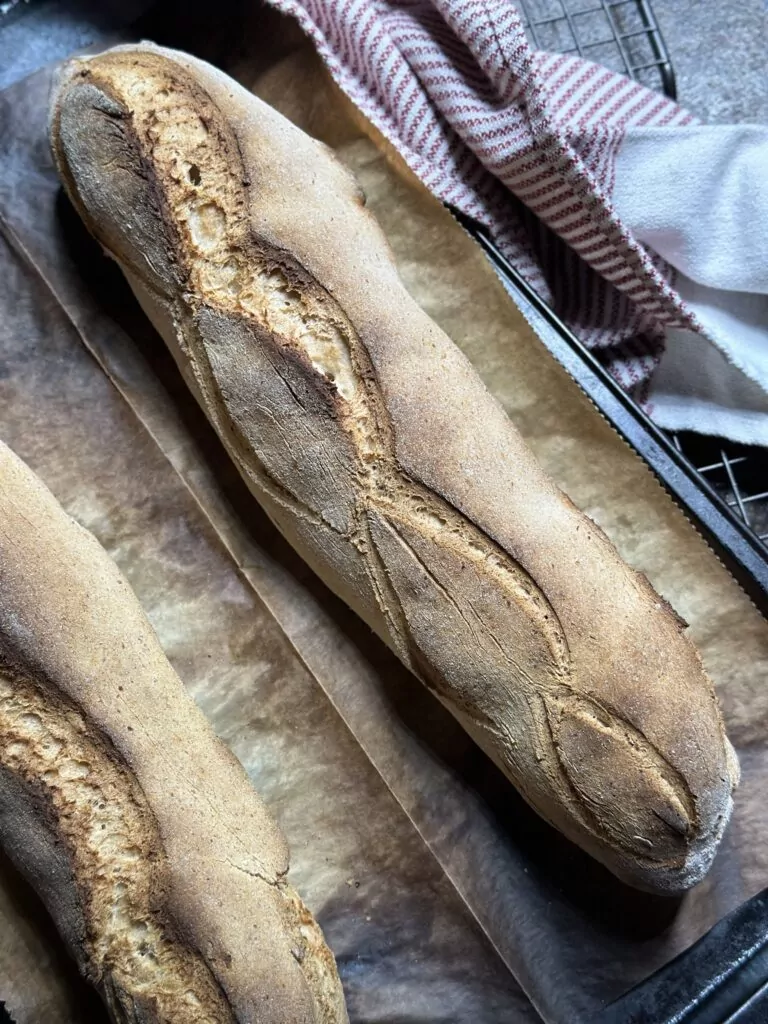

To make a homemade gluten free sourdough starter, hop to this recipe!
Gluten Free Sourdough Bread Recipe
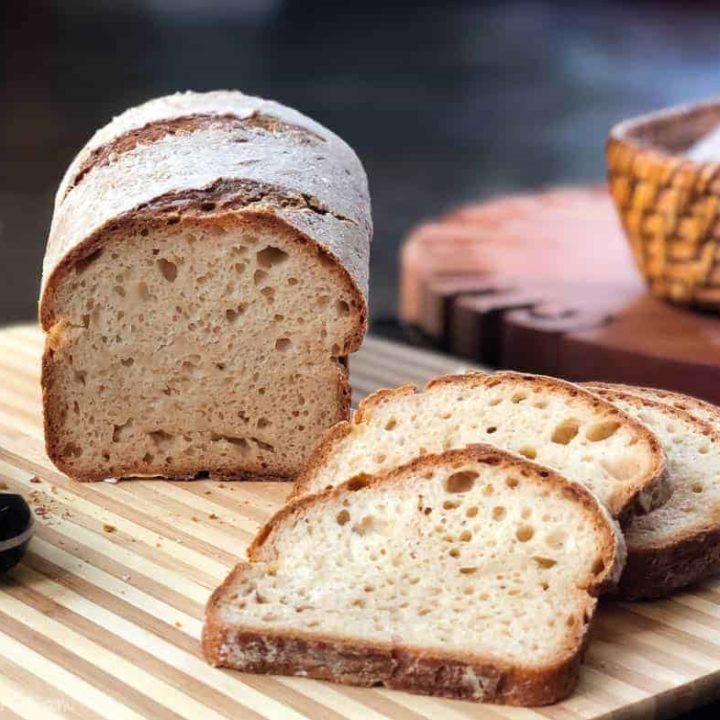

Gluten Free Sourdough Bread Recipe
This comprehensive gluten free sourdough bread recipe explores all the nooks and crannies of how to make the perfect gluten free loaf!
Ingredients
Sourdough Loaf or Artisan Bread Dry Ingredients
OR
- 3 cups (405 grams) gfJules® Gluten Free All Purpose Flour
- 1/4 cups (35 grams) gfJules Corn-Free Multigrain Flour OR cassava flour (OR buckwheat flour OR almond meal)
- 1/4 cups (30 grams) dry milk powder (OR coconut milk powder)
- 1/2 tsp. baking soda
- 2 tsp. baking powder
- 1 tsp. sea salt
PLUS These Other Ingredients
- 2 large eggs (OR 2 Tbs. flaxseed meal steeped 10 minutes in 6 Tbs. warm water)
- 2 Tbs. apple cider vinegar
- 1/4 cup olive oil
- 1/4 cup sugar
- 1 Tbs. psyllium husk powder (recommended) OR 3/4 Tbs. xanthan gum {DO NOT ADD either with gfJules Bread Mix}
- 3/4 cup gluten free sourdough starter
- 1 1/4 cup club soda, sparkling water, ginger ale, 7-Up OR naturally gluten free beer {ADD ONLY 1 CUP still water or sparkling liquid with gfJules Bread Mix}
Instructions
Bring all ingredients to room temperature.
Preheat oven to 200°F.
Beat the following ingredients together in a large mixing bowl: eggs (or substitute), apple cider vinegar, oil, sugar, psyllium husk powder and gluten free sourdough starter. Mix until smooth and thickened, approximately 2 minutes.
Slowly stir in dry ingredients or gfJules Gluten Free Bread Mix with bubbly liquid, beating with paddle attachment on a stand mixer or using a wooden spoon until the batter is smooth and all dry ingredients are completely integrated. Mix for two minutes with mixer, longer with spoon method.
If Baking in Loaf Pan:
- Transfer dough to an oiled Pullman Pan or 9x5 loaf pan, lightly dusted with gfJules Flour, or to oiled and floured parchment-lined pan or bowl for rising. Dust the top of the dough with more gfJules Flour and brush with olive oil for best results.
- Cover with oiled plastic wrap and set inside oven. Turn oven off and turn light on.
- Allow the dough to rise for at least 1 1/2 hours, or up to 3 hours before baking. Alternatively, after 3 hours, remove to refrigerator for overnight rise. If refrigerating overnight, bring the dough to room temperature before baking the next day.
- Preheat oven to 350° F or 325° F convection.
- Remove plastic wrap and slice the top of the dough to direct the rise, as pictured.
- If you prefer a very crunchy crust, fill a spray bottle with water and spritz the dough before baking, and again every 15-20 minutes while baking.
- Bake loaf in the pan for 75 minutes before testing with a bread thermometer. The internal temperature should reach at least 205° F before removing to cool. If the bread is browning too much, cover with foil in order to keep baking.
- Once bread is fully cooked, remove to cool on a wire rack for 15 minutes before removing from the pan. Allow to fully cool before slicing.
If Baking Artisan Bread:
- Transfer to a proofing basket (as pictured), bowl or oiled parchment-lined glass bowl.
- Cover loosely with a warm, damp tea towel or piece of oiled parchment paper and place in a warm spot to rise for 30 minutes - 1 hour or up to 3 hours before baking. Alternatively, after 3 hours, remove to refrigerator for overnight rise. If refrigerating overnight, bring the dough to room temperature before baking the next day.
- Invert onto a parchment lined baking sheet and remove basket or bowl. Dust with more gfJules Flour or brush oil on any dough that hasn't been oiled previously.
- Preheat oven to 475° F and bake for 5 minutes, then reduce to 425F and bake for 30 minutes or until bread reaches at least 205F internal temperature.
Notes
*for Gluten Free Sourdough Baguettes made from gfJules Bread Mix, add:
- 56 grams sugar
- 1/4 cup olive oil
- 2 Tbs. apple cider vinegar
- 3/4 cup sourdough starter
- 1 cup warm water
Follow package directions to make the dough but do not add yeast packet. Form, rise, then bake at 475° F for 5 minutes, then reduce to 450° F for 20-22 minutes, or until internal temperature is at least 205° F.
Recommended Products
I may earn a small amount from qualifying affiliate purchases; this amount goes to fund this blog and does not cost you anything additional.
-

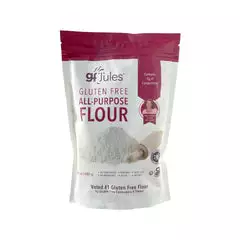 gfJules All Purpose Gluten Free Flour
gfJules All Purpose Gluten Free Flour -

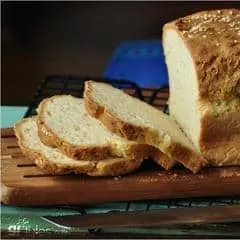 gfJules Gluten Free Sandwich Bread Mix
gfJules Gluten Free Sandwich Bread Mix -

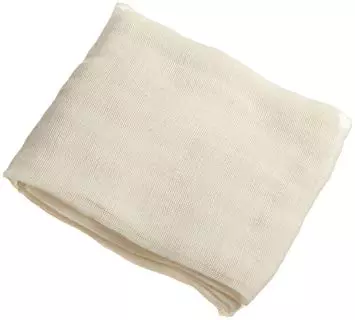 Regency Wraps RW450N, 9 Sq. ft, Natural
Regency Wraps RW450N, 9 Sq. ft, Natural -

 Bragg Live Food Organic Apple Cider Vinegar 946ml/32fl oz
Bragg Live Food Organic Apple Cider Vinegar 946ml/32fl oz -

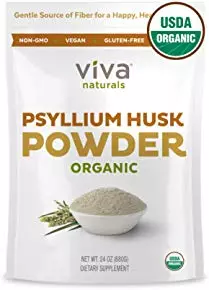 Viva Naturals
Viva Naturals -

 Empty Amber Glass Spray Bottles with Labels (2 Pack) - 16oz Refillable Container for Essential Oils, Cleaning Products, or Aromatherapy - Durable Black Trigger Sprayer w/Mist and Stream Settings
Empty Amber Glass Spray Bottles with Labels (2 Pack) - 16oz Refillable Container for Essential Oils, Cleaning Products, or Aromatherapy - Durable Black Trigger Sprayer w/Mist and Stream Settings -

 Norpro NOR-3952 12" Bread PAN, Non-Stick, 12 inch
Norpro NOR-3952 12" Bread PAN, Non-Stick, 12 inch
I can’t wait to hear about your gluten free sourdough bread baking!
Pin for later!
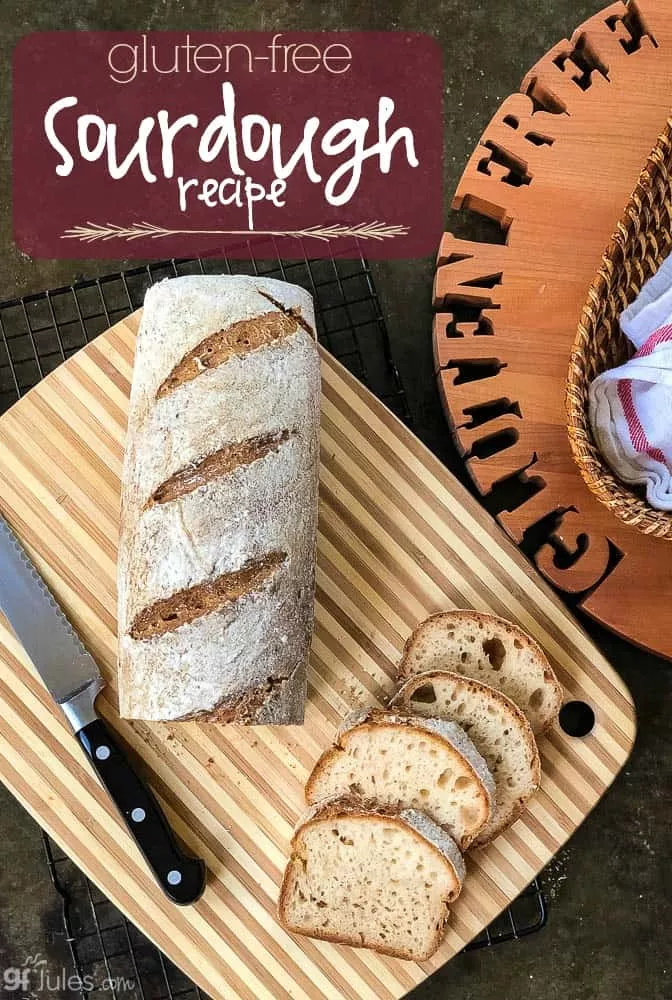

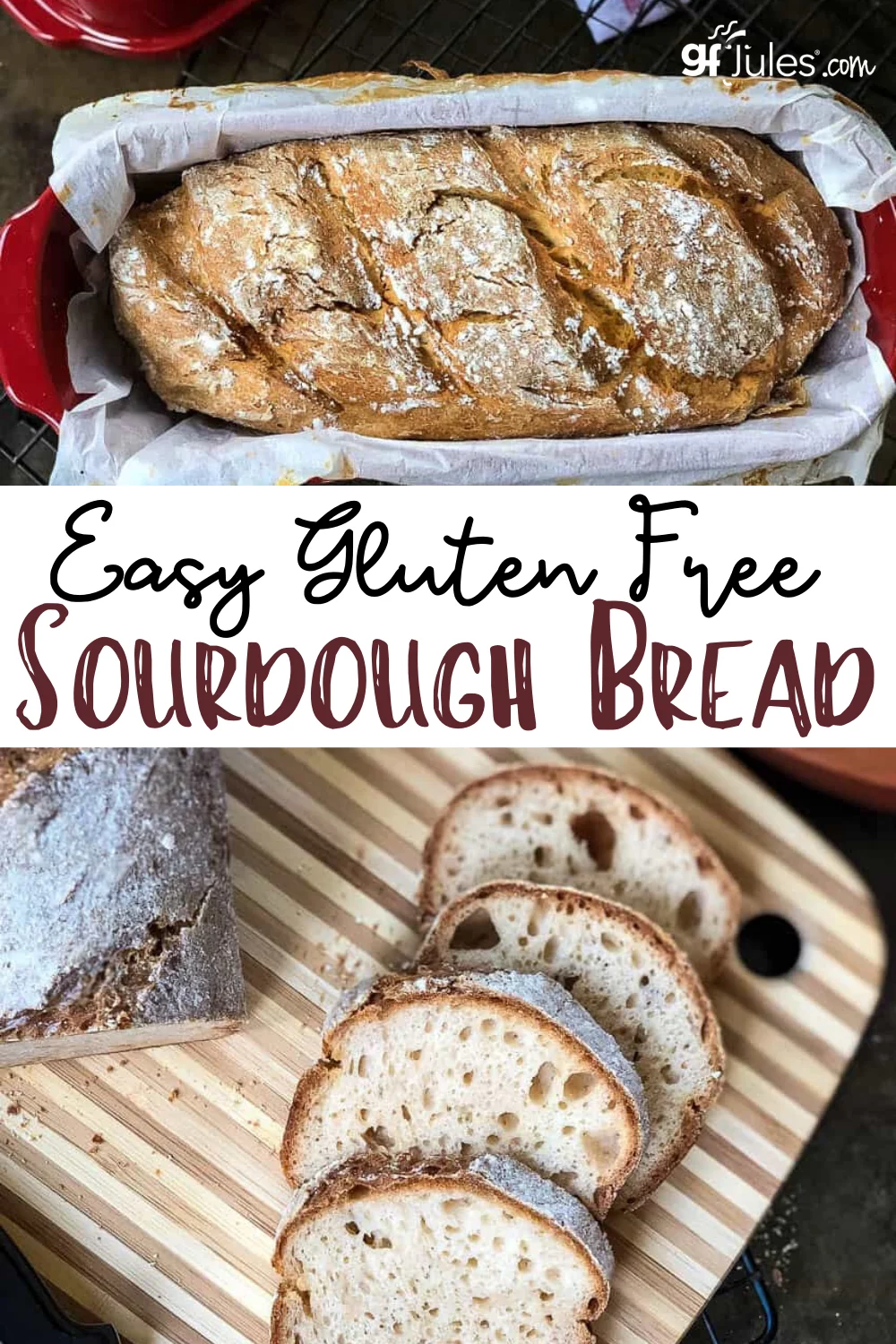

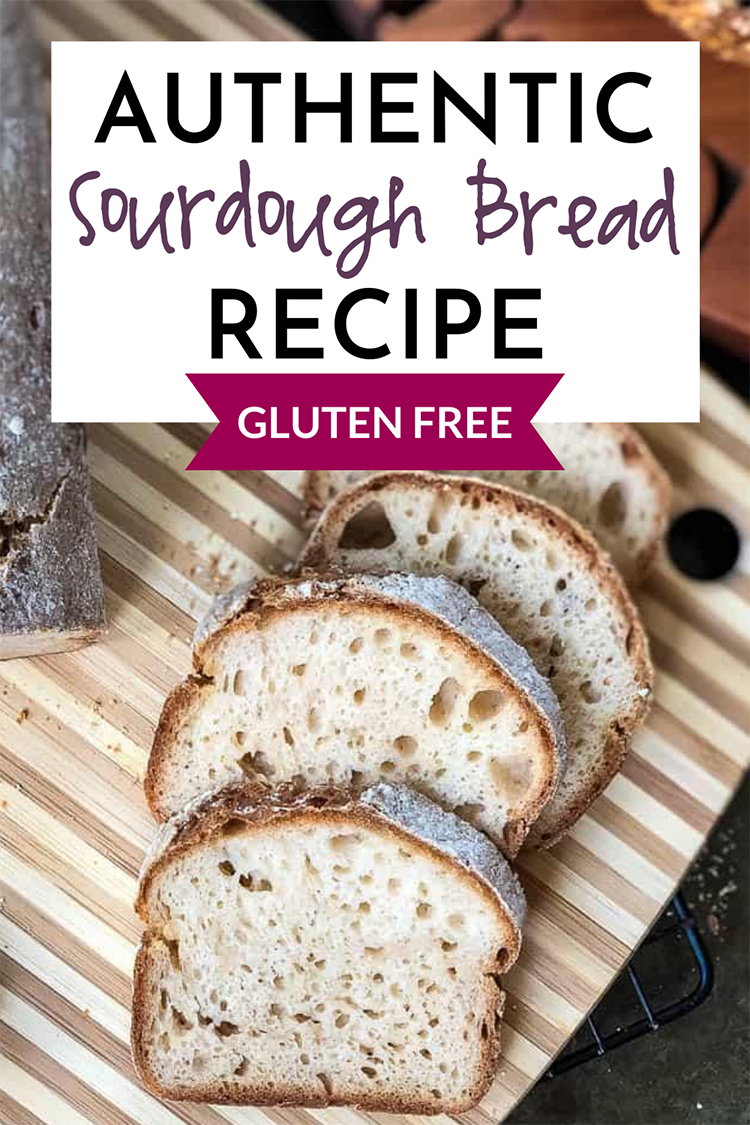

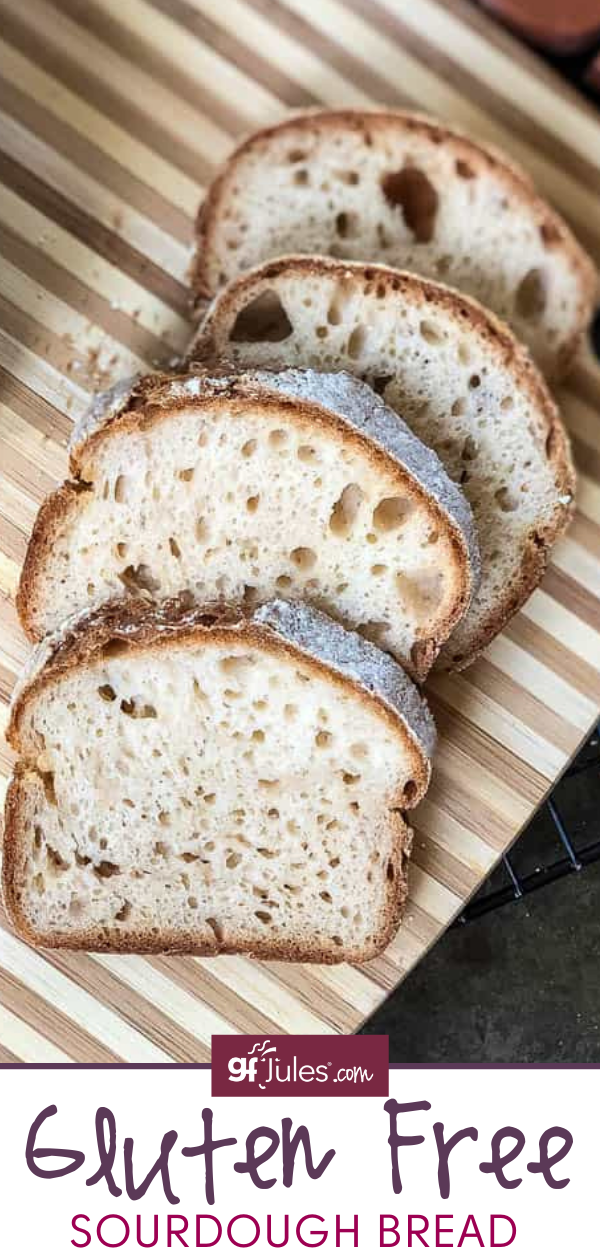

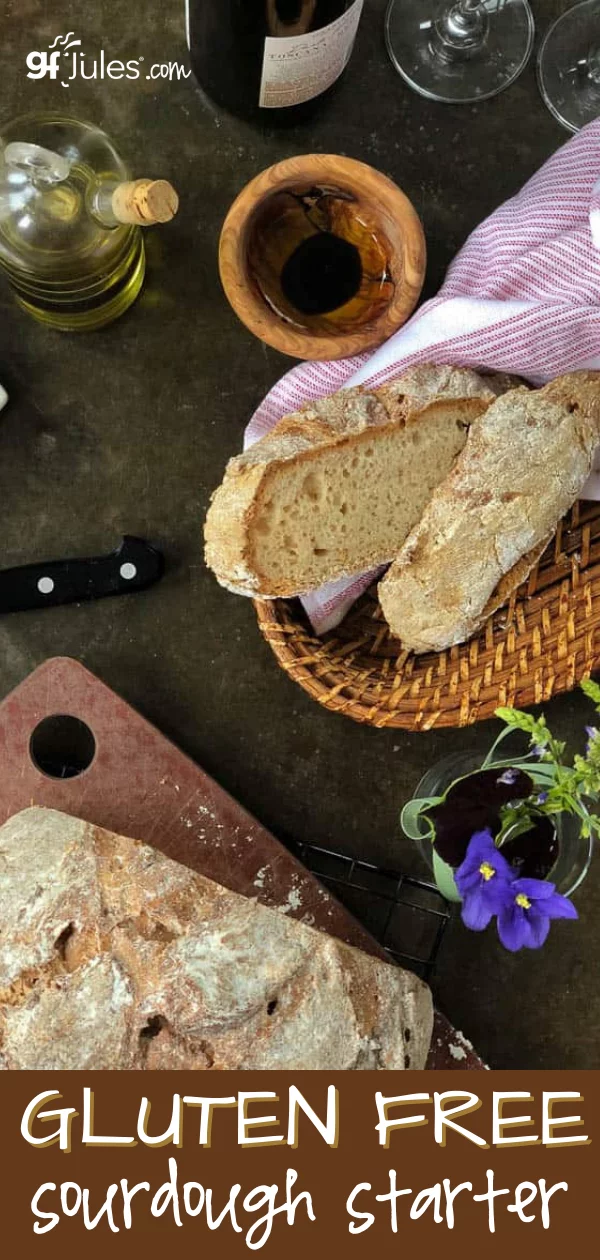






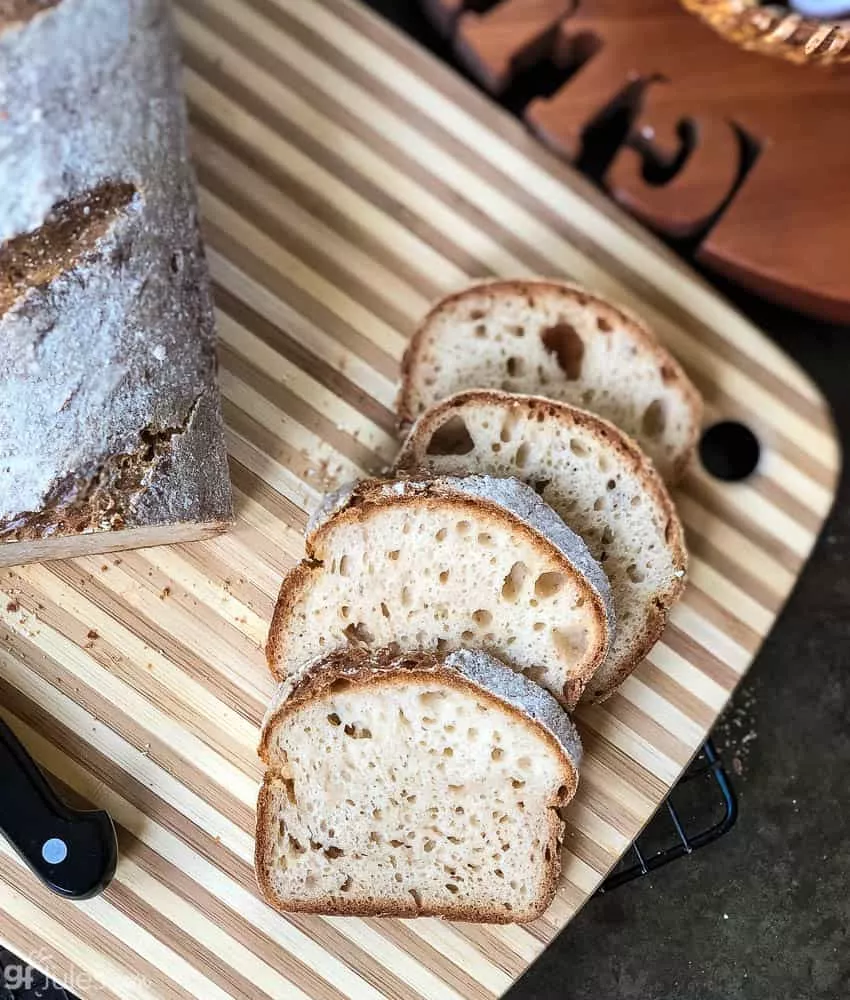
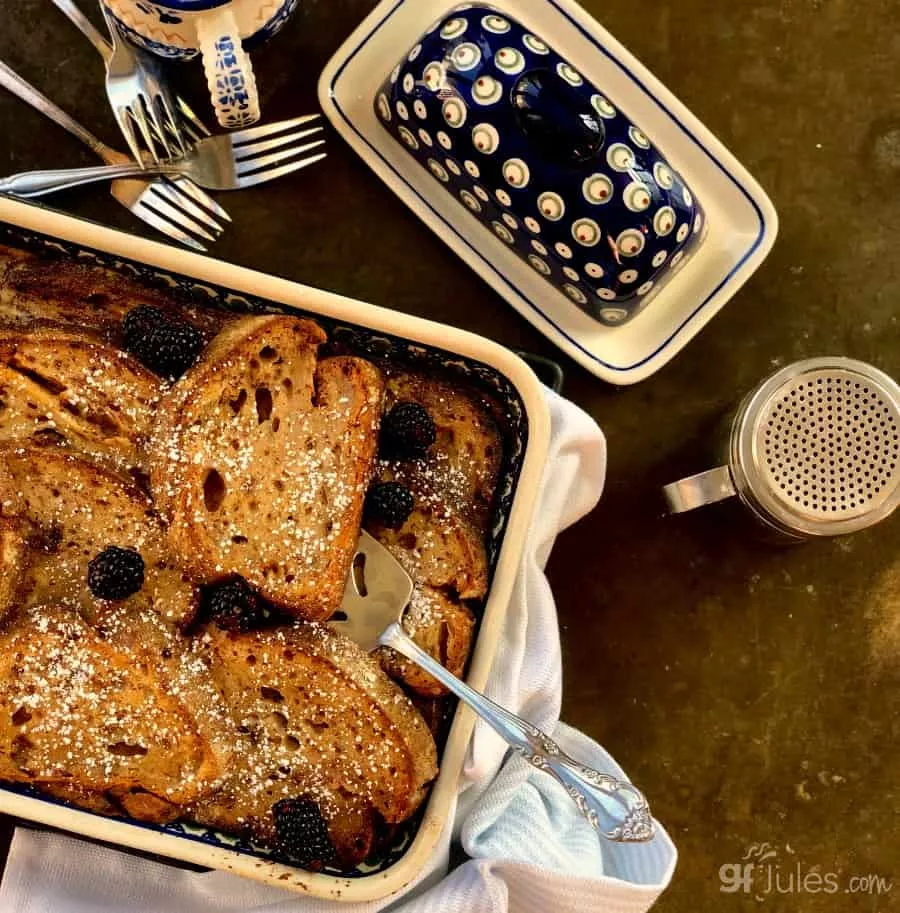











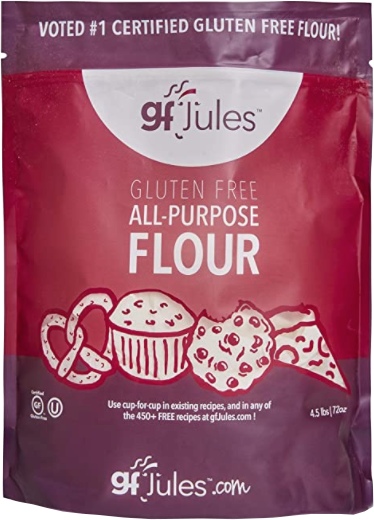
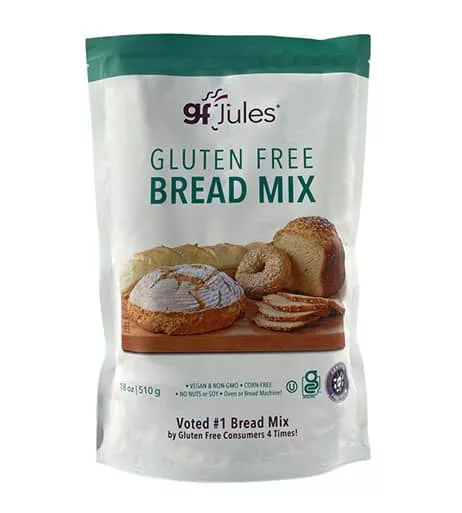
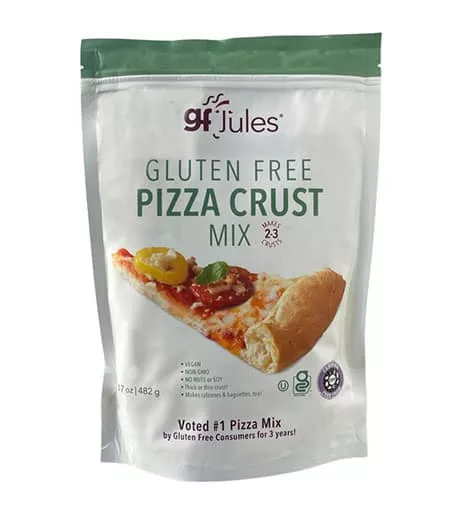
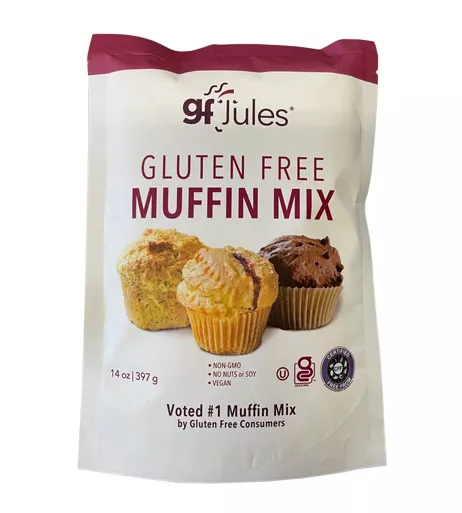


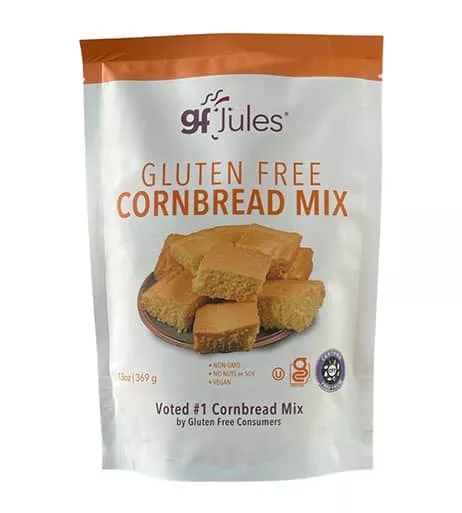



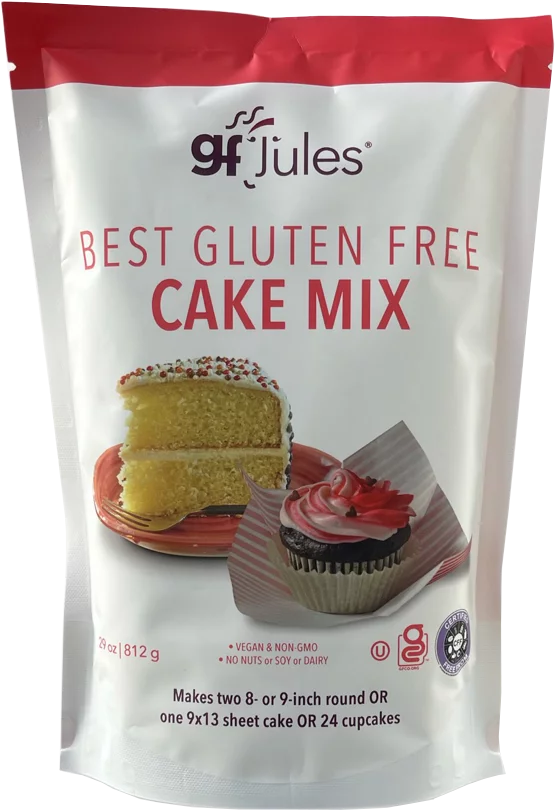
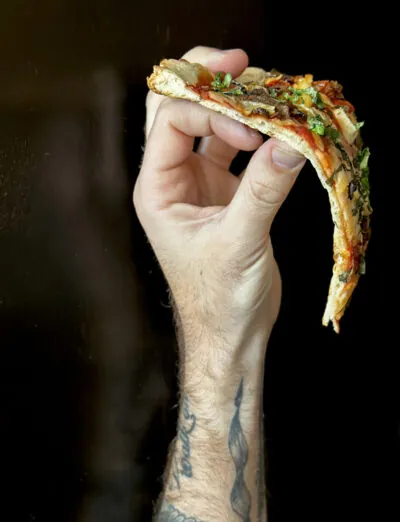

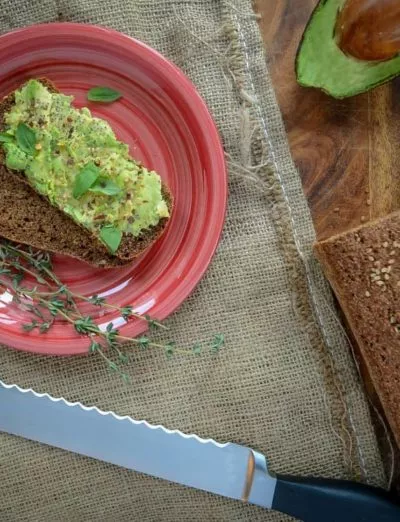
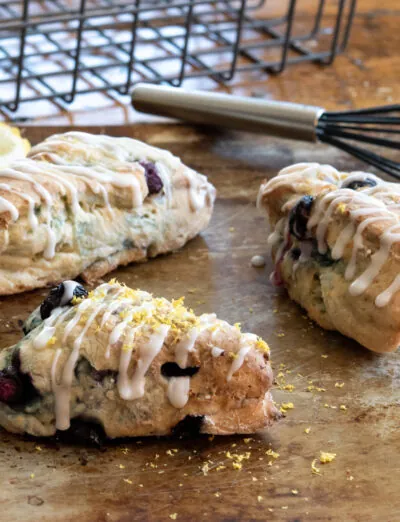

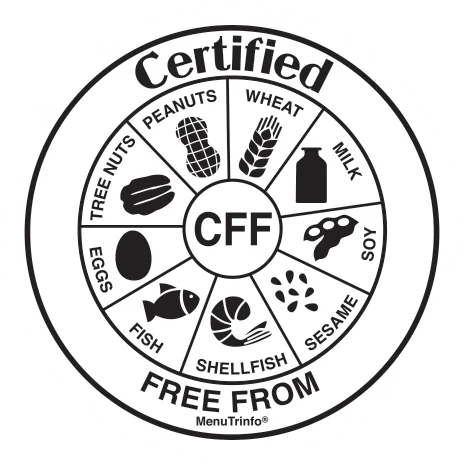

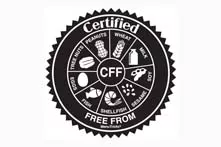
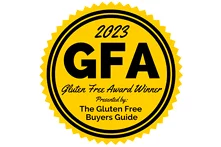
Where do I buy your special flour in Australia?
Thanks Chris.
Hi Chris, we actually ship to Australia from our Shop, or you can check this article on making a homemade blend if you prefer to go that route. Hope that helps!
~jules
Go raibh mile maith agat / A thousand thanks in Irish. I have been experiencing with flour mixes from the gluten free alchemist but your description of baking time, shape and temperature are helping with the final steps = 205 degrees F. I have a larger loaf than your recipe but had been using times I normally use with wheat sourdough but this one takes 1 hr 35 as compared to the wheat bread closer to 1 hr
So happy to be of help, Ryan! Your loaf looks like a beauty! Thanks so much for sharing! 🙂
Happy baking!!!!
~jules
I’m up here in osoyoos 🇨🇦 what is your mix ? I have my sourdough starter ready to use 🙂. I’v always mixed my own flours ….
More economical 🙃…. Thxs. Can’t wait to try. Katherine
Hello there, northern neighbor!! Check out this article for gluten free flour info — hope it helps you gather some ingredients you have access to there. Happy baking!
~jules
I accidentally left out the coconut milk powder this time. I’d put it in the pans before I remembered….. good new though it still looks delicious.
Currently I’m having success with an amrith starter and a mix of a homemade gf flour mix and a commercial one from the Indian grocer with mix of soy, besan, lentil, tapioca, moving, maize, sorghum and xanthan gum.
Posting this, it may help someone. I’ve made the sourdough bread the way the recipe is written and with no sugar and with half the sugar. I like it best with half the sugar but no sugar is pretty good too. I also like it with a flax egg instead of a regular egg.
Thanks so much for sharing your experience with this Gluten Free Sourdough Bread Recipe without the sugar and with reduced sugar. It’s so helpful to hear from someone who’s tried it that way themselves!
~jules
What can I substitute for milk powder and coconut powder? I’m allergic to both, but this recipe looks too good to not try! 🙂
Hi Jennifer, you’re going to think I’m crazy, and it will add a little sweetness to the bread, but using gluten free vanilla pudding powder will work as a sub!
~jules
Ok! I will try it, thanks!
Let me know how you like it!
~jules
I want to do this without sugar – my starter was made without sugar and my body does not agree with almost any sugars.
Is the sugar to make the structure of the bread hold up or Is it just a flavoring agent? If I just nix it, will I be risking a bread collapse?
Hi Milena, you should be ok nixing the sugar here. Let me know how it goes!
~jules
What is the purpose of the milk powder? Can I substitute something else in the place of it?
Hi K, the milk powder is for protein and cell structure here — it helps to keep the bread from collapsing after rising and cooling. I use coconut milk powder/creamer because I’m dairy-free. I’ve linked to one here for you in case that’s helpful.
~jules
I subbed for coconut cream in a tin and tweaked the liquid content a bit (googled how to do that) and it worked fine. I found a vegan powder now so am currently baking a loaf with that so will be able to compare.
That’s great, Rachel! I’d love to know more about your tweaking ratios and the vegan powder you’re working with now — always curious what’s working for folks!
~jules
I’m about to do another batch with the coconut milk powder. The brand is called hello pure. The first try with it was a bit heavy but tasted nice. The mix looks lighter in texture this time.
I love the experimentation! Let me know how it goes and the differences!
~jules
Ok here it is! My first ever gfJules gluten free flour, sour dough bread! It’s delightfully tasty!👏 👍
Oh, and I plan to use the starter for many more of your delicious recipes!😋
The starter does become a pet, in the making. Lol!
I forgot to sift your flour. I let it rise a couple of hours in an antique oven with no switch to keep the lite on. So, I would remove and reheat the oven every once in awhile when it started to cool. It went to the frig for over night and really lost volume! I’m wondering if it got cooked a bit in the rise process? Anyway I’m anticipating a bite of this as it cools completely!
In the begining Preheat oven to 200F?
It is right?
From180F is already cooking actually baking slowly.
Pre cook? What is the temperature in side the oven if I put for the 3 hours rise?
To rise, if the room doesn’t already have a warm spot, I suggest an oven preheated to 200F THEN TURNED OFF. Definitely don’t leave it on 200F while the bread is rising or it will start to bake or just dry out all together! Hope that explains it.
~jules
Has anyone tried making this in two 1 lb loaf pans instead of a Pullman loaf pan? I think technically 1 Pullman pan holds the same volume as 2 standard loaf pans, but I was curious to hear if anyone had successful results with this. Thanks!
When does the club soda go in? I’m assuming with the wet ingredients.
Hi Lucy, yes, you’ll add the club soda with liquids, or at the end together with the dry ingredients at the end while mixing. ENJOY!
~jules
Thank you for the help. (You told me, below, to use a bigger pan). This time, I used a Pullman pan – and the outcome was improved in that I no longer had the “removable cap” of bread. BUT, I still have a gel-like consistency inside. I would call it under baked (it looks underbaked) – but it’s not. I’ve made loaves to 205 degrees, 210 degrees, and this one I baked for an extra 20 minutes (total 95 minutes) and got to 215. Same thing happens. Even asked another person’s opinion – the bread consistency is sticky and gelatinous. Really hard to explain. It doesn’t show up well in pictures- but I included one. You can see how the middle and bottom of the loaf looks different – that’s where the “gel” is. Help!!!
That is odd because in your other loaves where you had the “shelf” it looked like part of the bread was cooked fine and other parts of it were more like this uncooked gel texture, right? Or was that me reading into what you were writing and the photo? Were there parts that were cooked and more bready in the other pan?
I’m not sure what’s going on with your sourdough, girl! The only thing I can see from what you’ve been describing that is different is that you’ve been using guar gum instead of xanthan. Guar can cause gumminess, so that could be a culprit. Did you use it in your starter or in your loaf recipe or both?
~jules
I misspoke when I said Guar gum, I use Xanthan gum.
It may just be undercooked. I wonder if cooking longer at a lower temp would help?
worth a try!! let me know how it goes!
This recipe is fantastic! I’ve had starter in my fridge for close to a year and make this bread every few weeks/freeze. Even if I forget about it for a couple of weeks, it always comes back. This week I wanted something different though. Seeing all the recipes for cinnamon raisin bread in my inbox but knowing I had starter I needed to use, I decided to try to combine the two and see what happens. Heaven, that is what happens! I added a bit of agave and a splash of vanilla to the liquids to sweeten the crumb a bit. I then added leftover a spice/sugar blend from apple cider donuts + more cinnamon to the dry ingredients. I ended with a bit of vanilla sugar for the swirl (because I had it) and I used yellow raisins because again, that’s what I had. I used a stand mixer so things were better incorporated, but I was careful to not over do the final swirl. I even forgot to let it rise/popped it straight in the oven (apparently I was a little excited, lol) and it came out amazing. So… while this recipe is fantastic, know that it’s also a great jumping off point for other goodness!
Oh Holly, that does sound like HEAVEN! So funny because I have some leftover spice/sugar from my Maple Pumpkin Cobbler that I might just have to repurpose for this idea instead of another cobbler! Have you checked out my gluten free Cinnamon Raisin Bread Recipe? I have a swirl technique that even works in a bread machine — you might want to give it a look for next time, because it sounds like there will definitely be a next time for this sourdough twist! Thanks so much for sharing the inspiration with us all!!!!!
~jules
Ok – so this question is for real. I’ve tried this recipe several times, and the same thing happens every time. It rises a little before baking. During baking it rises very well and comes out nice and golden brown on top. As soon as I take it out of the oven – it collapses like a balloon, with a “shelf” of crust on top (see pic). This time, when I removed it from the pan, the shelf came out separately from the “base” (see pic). It’s like it bakes with a big air space inside separating top from bottom.
I still let this one cool, then slice, and the inside is partly gelatinous (best word I can use to describe), partly looks like bread (see pic). Almost as if ingredients have separated while baking. Of note, I use the guar gum, and I usually sub honey (3tbs) for the sugar. (Though I did use the sugar once and the same thing happened.). On most of the loaves I did a 2-3 hr rise, and on this one did the overnight rise thinking that might change the outcome. Same problem. This is frustrating and I’m about to give up. Any suggestions?
More pics
Pic #3
PS – this only happens with the sourdough recipe. I make the sandwich bread recipe all the time and it is always fantastic.
It looks to me as if some ingredient isn’t mixing well with the others. Like they’re baking in separate parts of the loaf, if that makes sense.
The good news is that I think I have an easy fix for most of this problem, Terry! I’m not entirely sure about that swirl through the middle that seems kindof uncooked, but maybe this fix will solve it too (the rest of the bread looks beautiful!) — we’ll see! I think you have way too much sourdough for that pan. This shelf look has happened to me before and basically it’s when the loaf begins to rise above the pan and bake but it’s almost as if it bakes as two separate loaves because it’s another loaf on top of the one in the pan (because there’s too much dough). Because one is in a metal pan and one is not, they are baking inconsistently and they break apart. At any rate, if you don’t have a larger pan, you’ll need to separate this dough into two pans and try it again that way to see how it bakes and then give it a go to see if you can get one loaf to hold together that way as you do with the sandwich bread recipe. I think you’ll see much better results with this easy fix — fingers crossed!!!
~jules
Thank you for the help. This time, I used a Pullman pan – and the outcome was improved in that I no longer had the “removable cap” of bread. BUT, I still have a gel-like consistency inside. I would call it under baked (it looks underbaked) – but it’s not. I’ve made loaves to 205 degrees, 210 degrees, and this one I baked for an extra 20 minutes (total 95 minutes) and got to 215. Same thing happens. Even asked another person’s opinion – the bread consistency is sticky and gelatinous. Really hard to explain. It doesn’t show up well in pictures- but I included one. You can see how the middle and bottom of the loaf looks different – that’s where the “gel” is. Help!!!
Hi Terry,
How long are you letting the sourdough cool before slicing? I got very eager and sliced a boule only after a couple of hours and, while it was cooked well, it was wet and gummy at the core. Fellow “sourdoughers” educated me that the loaf/boule has too cool COMPLETELY and let any moisture settle and/or escape. Now I leave my bread on the counter overnight and slice it in the morning – excellent texture.
You show an AWESOME crumb here!
Good luck!
Great tips, Sandy!!!
~jules
I’ve tried to make the starter now several times, using the recipe you lay out here. Every time I try, things start out great! Starter gets active within 24 hours and stays active for about 3-4 days. By the 4th day, the starter stops growing. I’ve tried all of the methods of “activation” you outline – adding more apple cider vinegar, adding honey, adding more yeast. Nothing seems to work. It smells “tangy” by day 2 every time. It’s in a relatively warm spot in my house.
With one of the batches, I tried using it to make the bread and it seemed to rise in the oven just fine. But it had no sourdough taste. What am I missing! I have a batch currently “incubating” and am now on day 5 – so maybe somebody can suggest a revival protocol in the next day or so? Thx.
Whoops – just noticed this question has been addressed a few times.
Hi. I was reading about your starter. I’ve had a starter going for about 3 months now on a table in a cool area in the house. If you notice it „dying“ add 1/2 cut water and 1/2 cup of gout morning and night. I use a combination of flours. One day I use Teff and another whir rice and another brown rice. Teff adds an interesting color and activity. If you get that gross sludge on the top simply remove it. If you find you have too much starter, drain off 1/3 cup each time you add. After about 3 or 4 days you can switch to feeding the sourdough starter to once every few days. I use the starter for everything like pancakes, cookies and waffles to name a few. I add about 1/3 cup amd generally slightly reduce the liquids. But my starter has done well. I added a tiny bit of yeast when I started it from scratch but no sugars. Now I just “feed it” every few days and replace the glass bowl it’s in. I don’t use stainless steel, only aplastic spatula snd I use tap water.
Sorry “gout” should have been flour. Have to laugh.
saw that and I did have a giggle!!!!
~jules
Hi Julie – thanks so much for taking the time to share your experiences with this gluten free sourdough recipe, and the other combos of flours you’ve added to the starter to feed it. I’ve so enjoyed hearing everyone’s sourdough stories and I know it helps others to hear and learn from each other on this baking journey!!!!
~jules
Hi,
Thanks for this recipe, it’s the best I’ve tried so far!
My result however looks quite a bit different from yours. My bread (not baked in a pan) is quite flat, and also dark. When I first make it, the dough is white, but after a few hours of resting in a warm oven it gets very dark. Do you have any thoughts regarding the lack of rise and dark color?
The only difference I can think of between your recipe and my implementation is that I didn’t make my GF starter from your recipe. I’m thinking that this could maybe be having an effect, but my starter rises nicely when I feed it and I add it to the recipe when it’s at its peak activity.
Thanks!
Hi Emily, depending on the gluten free flours you use, the color will differ for sure. Buckwheat, for example, can tend to make doughs look grey. I’m not sure what flours you’re using, so it’s hard to guess. Regarding the flatness of the dough, you could try leaving it in a mold longer — for the rise, at least — so that it has longer to stay in a supported shape. Check out my Gluten Free Artisan Bread Recipe for more tips on this method. So glad you’re enjoying the gluten free sourdough recipe!
~jules
Thanks for the advice! I’m using your flour mix, almond flour, and dry milk powder. It’s so weird, the dough is white when I first make it and then it darkens. My hypothesis is that the psyllium husk has a reaction to other ingredients over time which darkens the dough, I really can’t think of anything else. I’ll try making it in a bread pan next time to see if that helps the rise.
My dough is also very sticky and wet, I can barely grab it all into one ball, and I certainly can’t smooth it out. The pictures you have suggest that the top is smooth at the end of baking, mine is all bumpy (maybe the lack of rise is causing this). Do you think adding a bit less water would help? Especially since almond flour is a pretty moist flour. Thanks!
Hmmm, ok. The three variables we’re really working with here are the starter variable, almond meal, and the milk powder. Since I don’t know anything about the starter you’re using, that’s a big one. Regarding the milk powder — I assume that’s a dairy milk powder you’re using? I don’t think the psyllium husk is causing the darkness, as I haven’t experienced that in any of my loaves; I really think that it must be one of the other three variables since I don’t (obviously) use your starter, or almond meal or dairy milk powder. You could try a different milk powder and see if that makes a difference in color and if not, then I would say the color must be coming from the starter, as almond meal doesn’t usually cause a very dark color, although it’s possible. The almond meal would not make me suggest adding less water, since almond meal is a gluten free “flour” that usually requires adding more liquid, rather than less. I wouldn’t be concerned about the consistency of the dough being sticky and wet, as most gluten free bread doughs are like this. (You may want to invest in a proofing bowl like I show in my Gluten Free Artisan Bread Recipe if you’re really interested in baking without a pan so that it gives the bread the support while proofing.) How do you mix your dough, though? Is it bumpy before you are done mixing or does it become bumpy looking after rising?
~jules
Hi Jules, Thanks so much for sharing this recipe! I’ve made one starter using a different GF flour blend, and the results were good not great. So I ordered some of your flour blend and am now having a hard time getting the starter to activate. It was great (bubbly, active) after 3 days, but since then no noticeable activity. I tried adding an extra tablespoon of yogurt around day 6 and that didn’t help, and then an extra tablespoon of apple cider vinegar around day 8 and that didn’t help either. Wondering if I should just try to cook a loaf with the starter as is, or if there’s something else I should try, or if I should just scrap this batch of starter and try again… Thoughts? Thanks so much!
Hi Sara, you may have already looked through the extensive comments and seen that this is a common occurrence so I hope you feel like you’re not alone! Don’t scrap it, for sure! Adding honey or another high protein flour (quinoa or sorghum or even almond have seemed to help for some readers) have shown more activity, but basically the starter is still alive, just a bit lethargic. You can go ahead and bake with it or try one of those options to wake it back up. If you haven’t been discarding some all along, definitely do that, or at least divide it and follow the recipe to add the extras as you’ve tried and maybe try one of these other options, then keep it in a warm environment and see if that helps first. The name of the game with these starters is longevity, and you’ll notice that it’ll take some time before it develops that nice sour flavor, too, so hang with it and don’t lose hope or discard it! Let me know how it goes! Also, if you are on FB, join the gfJules Gluten Free Recipe Share Group — there’s a really active group of gluten free sourdough bakers on that forum who are great about answering questions and sharing all they’ve learned, too! Good luck and happy baking!
~jules
Thx so much for this great recipe, Jules! This was my first loaf of sourdough ever and the texture was amazing for gf. Used your bread mix & flour, followed the recipe exactly, using gf beer as the bubbly liquid. The only issue I had with it was that even after an overnight fridge proof, it wasn’t very sour! And it was super sweet, maybe b/c of the beer plus sugar? Def wanna try with no sugar or less next time and also I think my starter is too new for it to be super sour. But otherwise so grateful for the recipe and I’ve shared your link with a gf sourdough group on FB! 💖
That’s wonderful to hear, Kylie! So happy it turned out so well for you! And yes, the gluten free sourdough starter definitely needs to age a bit before that sour taste really starts to develop a lot. I’m so excited for you to have great sourdough back in your life! ENJOY!!!
~jules
Hi Jules!
I’ve made a few loaves of this sourdough bread and it is delicious; however, the bottom is consistently under baked. I’ve been baking it in a Dutch oven without the cover. I’m using almond flour, dry milk powder, sparkling water, and xantham gum. I bake the bread for an hour and a half at 350 degrees. I do live in Arkansas in an incredibly humid climate. Do you have any recommendations?
Hi Emi, are you just using almond flour as the flour or are you using a gluten free flour blend as well?
~jules
I am using your gluten free flour. I am only using almond flour in place of the cassava flour.
Ok, so I have a couple of recommendations, starting with the bake time and temp. Try lowering the temp to 325F and baking longer. Are you taking the internal temp with a thermometer before removing it? If it’s 205 and still not baked on the bottom, then it’s time to change pans. Just testing every variable. Particularly because the bread tastes great and is cooked elsewhere, that would be the next variable to change and test. One more thing you could do would be to change the rack position in your oven and bake the bread closer to the bottom of the oven where the heating element is.
Are you on FB? If so, I would also recommend joining the gfJules Gluten Free Recipe Share Group. It’s a great, supportive group of folks — many of whom are baking tons of gluten free sourdough loaves! They are doing lots of testing and have even more suggestions if these don’t work (although fingers crossed they will!). Let me know how it goes though, ok? One or more of these should take care of the problem.
~jules